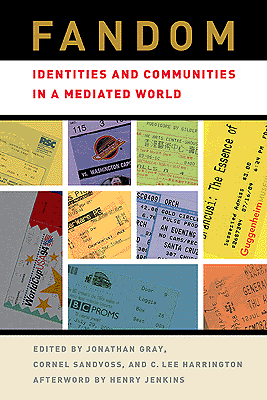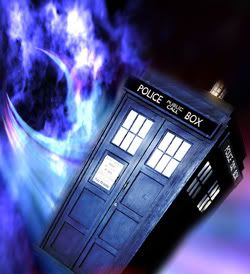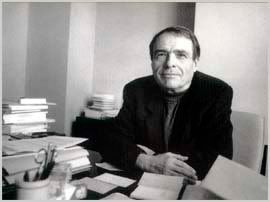http://flowtv.org/?p=109
Taste and Fandom
Posted by Louisa Stein and Kristina Busse on November 17th, 2006
Taste Matters
by: Louisa Stein / San Diego State University
The innovative roundtable structure of the Flow conference facilitated inviting, ongoing conversations. Throughout the conference, I found that ideas raised in earlier panels fruitfully informed and contextualized my engagement with later discussions. For me, the question of taste and evaluation (the topic of my roundtable) emerged as a linchpin in later discussions, particularly those addressing media engagement and the relationship between niche and mainstream audiences. Indeed, I think that incorporating an awareness of taste and evaluation is critical for our analyses of media engagement past and present.
When we try to figure out how our evaluative stance, how our taste fits in with our academic study (be it of TV programs or TV audiences), one dimension of what we're after is how we (as TV scholars and as TV viewers–dare I say fans) fit in relation to mainstream television consumption. During the conference, this question of how we negotiate these different elements of our subjectivity turned to discussion of pedagogy: how can we deal with the fact that in addition to being professors, graduate students, etc., we're also TV viewers with tastes, albeit informed by our academic investments? The taste cultures from which we emerge influence not only what work we choose to do and how we frame that work, but also how we teach TV, what programs we show in class, and what we say about them. Larger questions of how we engage with media and media culture underlie these inward interrogations of the role of taste in our teaching and scholarly work: As TV studies academics, are we a niche? Are we participants in multiple, overlapping (and differing) niches? And how should our positioning affect what we do as TV scholars and teachers of TV?
I fully believe that we have much to gain from integrating our taste into our work and teaching–for our taste will influence us whether we acknowledge it or not. But I would caution against the impulse to equate our taste–not only regarding the programs that we admire, but also the strategies that we admire–with mainstream tastes or with fan tastes. As Kristina Busse points out, such recognitions of similarity can be dangerous; we can lose site of the multiplicity and the specificity of media taste cultures. If we do not closely examine our own position as TV viewers, fans, and participants in online TV cultures, we run the risk of simply equating our own engagement with that of the multiplicities of TV audiences.
At the same time, I would argue that it's crucial that we not overlook the potential connections to be drawn between our media engagement, fannish engagement, and mainstream engagement; if we address the subtleties of our own taste cultures in relation to mainstream and fan taste cultures, the connections and the differences will become more evident. Indeed, in cases like the Lost websites discussed in the “Watching TV Off TV” panel, we do see forms of engagement akin to fannish interactions with TV and the Internet. In response to Kristina Busse's argument in this issue of Flow regarding the specificity of fan behavior, I would suggest that we consider fannish engagement not as something embodied, but as a mode of engagement which transcends self-identification and bodies, and which can be offered and encouraged by the new media interface. These seemingly fannish modes of engagement, interwoven into the interface, may indeed interpellate the Lost website user into fannish behaviors. However, the hailing of fannish modes by online commercial interfaces does not completely level the playing field. There are still differences in community context, cultural values, and yes, taste, which shape media engagement–and these differences surface most lucidly when we assess our own taste investments as well as those of the communities we study.
As scholars studying TV audiences, we often seem to seek out audience communities that appear to us to most closely align with our own taste cultures as academics. I'm not suggesting that we should stop studying the audience cultures that reveal themselves as complex, dynamic, intellectual, and self-reflexive, for the study of these communities is indeed crucial in any assessment of how people engage with media. But our delight in finding our reflection in organic TV communities comes laced with pitfalls. We may rush to dismiss a television program as not having an active audience culture because it doesn't line up with our specific assessment of fan-oriented TV as complex, multilayered, and literary (assessments which match an academic taste-culture.) Compounding this, in seeking out audience communities which seem to resonate with our own taste, we may mistakenly correlate academic and fan cultures, and thus oversimplify fan processes by relegating them to the status of “cult.” In so doing, we risk overlooking interconnections and parallels between fan engagement and (the diversities of) mainstream engagement.
Above all, I would argue that if we are too quick to dismiss our own situation at the intersection of multiple, specific taste cultures–if we strive to bypass our own tastes in order to jump to a non-evaluative space where all cultural work is equally good–our value assessments are simply made invisible. Only by negotiating (I won't say embracing, because that's for each of us to decide on our own) our own evaluative processes, our taste, and acknowledging how those processes fit within or work in conflict with the subject of our study, can we hope to paint a more nuanced picture of the complexities of media engagement. Of course, that might not be our goal–and that in itself is a matter of taste.
Fandom-is-a-Way-of-Life versus Watercooler Discussion; or,The Geek Hierarchy as Fannish Identity Politics by: Kristina Busse
Henry Jenkins has described fans as early adopters and adapters in terms of media engagement, which goes for technology (e.g., downloading episodes, remixing footage) as much as behavior (e.g., extremely close readings, character analyses). Throughout the panel “Watching Television Off-Television,” the emphasis was on how such behavior has become mainstream: casual media users now can engage with a universe that exceeds the television show via cross-media, cross-platform texts, thus creating a synergistic “overflow” experience. Thus, Jason Mittell offered the examples of Alternate Reality Games and additional online-only available footage, Will Brooker presented various fully immersive web sites that invite viewers into the shows' diegetic spaces, and Henry Jenkins commented on the current ease of streaming or downloading television shows. The mainstreaming of fannish behaviors is thus seen as advantageous even if (or maybe even because?) the industry clearly attempts to create such behavioral patterns in order to sell their products and/or supplementary materials.
The central caveat I'd like to offer is that we not wholly conflate such recreations of fannish behavior with fandom per se. In other words, I am worried that in mainstreaming fannish behavior, the concept of the TV and media fan as a self-defined identity, as part of a more or less well-defined community, may get lost, and that other defining characteristics of the fan may be overlooked. Derek Johnson's position paper for the panel illustrates such a theoretical fusion when he describes how “the hyperseriality of multiplatformed television makes it possible for viewers to enter and consume from a position within the vast, detailed, internally-coherent 'hyperdiegesis' ascribed to niche-oriented cult series.”
My central question is: How alike or different is such a commercially constructed position when compared to the space media fans have traditionally eked out for themselves? If behavior is similar, what ultimately separates “fans” from casual TV viewers who engage fannishly? Or, more specifically, how can we define fans without invoking a category so expansive that it includes all media audiences or one so narrow that it excludes large numbers of individualist fans? How can we create a continuum that acknowledges the more intense emotional and actual engagements of many TV viewers today without erasing the strong community structures which have developed through media fandom?
This gets particularly difficult when we start looking at cases in which casual users work collectively, thus creating virtual communities (as in the case of wikis). Likewise, it becomes difficult to encompass the individualist fans who may exhibit fannish behavior in private yet do not appear (or even consider themselves) part of a television fan community. Cornel Sandvoss, for example, defines fandom as “the regular, emotionally involved consumption of a given popular narrative or text” (8), thus wholly changing the definition from collective to individual and from activity to emotional investment. (The exemplary scholarly study for the former would be Henry Jenkins' Textual Poachers, whereas the latter is possibly best represented by Cornel Sandvoss's Fans.)
I want to suggest that we distinguish between fan and fandom as well as acknowledge that there are different trajectories that combine into levels of fannishness. In other words, an intense emotional investment in a media text that is wholly singular may create a fan but does not make the individual part of a larger fandom, whereas a person enacting fannish behavior may not define him- or herself as a fan. It thus might be useful to consider the overlapping but not interdependent axes of investment and involvement as two factors that can define fannish engagement. Moreover, we need to consider models that can differentiate between people who are fans of a specific text, those that define themselves as fans per se, and those that are members of fandom.
It is here that community- versus self-definitions of identity come into play. Politics of inclusion and exclusion are central to concerns over normativity and representability; such issues surface in the identity debates of queer theory and critical race theory but also play out in the subcultural identity politics of fandom. Making the definition too inclusive makes any term as useless as defining it too narrowly: if any TV viewer who visits a website has become a fan, how can we intelligently differentiate those for whom fandom is a central component of their everyday lives, affecting personal interactions and their very identities? Likewise, if we only define fans as convention-goers whose entire social network has been drawn from the fannish community, we exclude the emotional and intellectual engagement of large numbers of viewers for whom a given show may have immense impact on their lives.
I'd argue that defining a spectrum of fannish engagement might be more useful than trying to define “proper fans.” As someone who studies participants within specific fan communities, I feel we need to be aware what point of the spectrum we are studying. For example, Jonathan Gray argues that we need to consider positions of non- and anti-fans. His work serves as an example of a more widely differentiated approach to studying media audiences which could help to refine notions of fandom rather than simply universalize the concept. At the same time, we need to address our own subject positions as fans and academics and examine our investment in defining ourselves and others as fans. Commercially encouraged modes of engagement that employ modes of fannish identity do not create instafans; moreover, the types of engagement often vary, not only with intensity but also with creativity. In the end, I feel it is important to realize that playing a computer game or looking around a website may not be wholly the same as participating in a fannish gift exchange or contributing to a shared fictional universe.
Notes: The Geek Hierarchy can be found here.
Works Cited:
Gray, Jonathan. New Audiences, New Textualities: Anti-Fans and Non-Fans. International Journal of Cultural Studies 6 (2003): 64–81.
Jenkins, Henry. Textual Poachers: Television Fans and Participatory Culture. New York: Routledge, 1992.
Sandvoss, Cornel. Fans: The Mirror of Consumption. Cambridge, UK: Polity Press, 2005.
“Watching Television Off-Television.” Roundtable Discussion. Flow Conference. Oct. 26-29, 2006, Univ of Texas, Austin.



